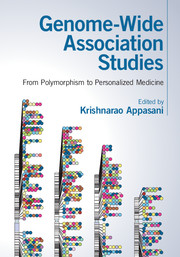Book contents
- Frontmatter
- Dedication
- Contents
- List of contributors
- Forewords
- Preface
- List of abbreviations
- Part I Genome-wide association studies
- Part II Genome-wide studies in disease biology
- Part III Single nucleotide polymorphisms, copy number variants, haplotypes and eQTLs
- Part IV Next-generation sequencing technology and pharmaco-genomics
- 15 Next-generation sequencing for rare diseases
- 16 Next-generation sequencing for complex disorders
- 17 Chromosomal breakpoints in breast cancer co-localize with differentially methylated regions
- 18 Signaling network analysis of genomic alterations predicts breast cancer drug targets
- 19 Pharmacogenetic studies in pediatric acute myeloid leukemia
- 20 Pharmaco-genomics of antiretroviral drugs
- Part V Population genetics and personalized medicine
- Index
- Plate section
- References
20 - Pharmaco-genomics of antiretroviral drugs
from Part IV - Next-generation sequencing technology and pharmaco-genomics
Published online by Cambridge University Press: 18 December 2015
- Frontmatter
- Dedication
- Contents
- List of contributors
- Forewords
- Preface
- List of abbreviations
- Part I Genome-wide association studies
- Part II Genome-wide studies in disease biology
- Part III Single nucleotide polymorphisms, copy number variants, haplotypes and eQTLs
- Part IV Next-generation sequencing technology and pharmaco-genomics
- 15 Next-generation sequencing for rare diseases
- 16 Next-generation sequencing for complex disorders
- 17 Chromosomal breakpoints in breast cancer co-localize with differentially methylated regions
- 18 Signaling network analysis of genomic alterations predicts breast cancer drug targets
- 19 Pharmacogenetic studies in pediatric acute myeloid leukemia
- 20 Pharmaco-genomics of antiretroviral drugs
- Part V Population genetics and personalized medicine
- Index
- Plate section
- References
Summary
Introduction
Currently several million people take chronic combination antiretroviral (ARV) therapy to suppress human immunodeficiency virus (HIV) infection. There are around 34 million people living with the HIV infection, most of whom reside in developing or under-developed nations. The combined antiretroviral therapy (cART) has prolonged life and prevented the progression of the disease. The cART has lessened the burden of the disease worldwide (Verma et al., 2014). Because of the long-term and multi-drug therapy, several complexities may arise which might affect adherence and tolerability in patients. Serious efforts must be made in order to make the pharmacotherapy of HIV infection efficacious with minimal adverse events. The use of ARV drugs has been associated with different types of toxicities including hypersensitivity reactions, metabolic disturbances, peripheral neuropathy, hyperbilirubinemia, neuropsychiatry disorders, and myelosupression (Subbaraman et al., 2007). Among several variables, such as age, sex, disease state, and drug–drug interactions influencing inter-patient variability in the spectrum of effectiveness and toxic effects of ARV drugs, host genetic factors may have a significant role in predisposing the patient to the variation in treatment outcome (Vidal et al., 2010). Polymorphisms in genes encoding drug-metabolizing enzymes, drug transporters, and other targets make the patient susceptible to variation in drug response. It is imperative to predict the genetic markers to optimize the therapy and select the best combination of drugs to avoid toxicity. The application of pharmacogenomics in clinical practice might help us to develop the notion of personalized medicine. Pharmacogenetic tests can provide the data on genetically determined inter-individual differences in pharmacokinetics and genotype–phenotype associations (Shah and Shah, 2012).
This chapter reviews the pharmaco-genetic aspects of variation in ARV drug response in HIV-infected patients. The most overlapping examples of the heterogeneity in the efficacy and toxic effects of ARV drugs as found between populations will be discussed here.
Antiretroviral drugs
ARV drugs are commonly used to prevent transmission or acquisition of HIV-1 infection. Current practice uses a combination of at least three drugs referred to as “highly active antiretroviral therapy” (HAART) in the standard-of-care therapy for HIV infection. Zidovudine was the first drug to be approved by Food and Drug Administration (FDA) to treat HIV infection in 1987. There has been remarkable improvement in the prognosis of HIV infection since 1995 with the use of HAART (Pirmohamed and Back, 2001).
- Type
- Chapter
- Information
- Genome-Wide Association StudiesFrom Polymorphism to Personalized Medicine, pp. 297 - 312Publisher: Cambridge University PressPrint publication year: 2016



